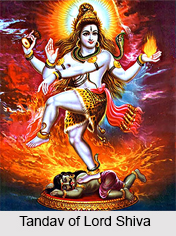 Mahadeva is one of the main deities of Hinduism that is worshipped as the paramount lord by the Shaivite sects of India. In Hinduism, Lord Shiva is regarded as the representation of the Supreme Being. He is known as the third element in the Hindu Trinity (Trimurti), the other two members being "Lord Brahma - the creator" and "Lord Vishnu - the protector".
Mahadeva is one of the main deities of Hinduism that is worshipped as the paramount lord by the Shaivite sects of India. In Hinduism, Lord Shiva is regarded as the representation of the Supreme Being. He is known as the third element in the Hindu Trinity (Trimurti), the other two members being "Lord Brahma - the creator" and "Lord Vishnu - the protector".
Mahadeva is the destructive form of the Almighty. As the cycle of destruction and recreation is always in a circle, Shiva"s primary responsibility is maintaining the life cycle. According to some scholars, Mahadeva as "Mahakaal" destroys and dissolves everything into nothingness but as "Shankara", he also reproduces that which has been destroyed and dissolved. His symbol of Lingam or the phallus represents this reproductive power.
Appearance and Attributes of Mahadeva
Mahadeva is often shown with many faces, as creator, destroyer and preserver in total command of the cosmos. Lord Shiva is shown either in Meditating or in the form of a Dancing God "Nataraja" where his dance is to the beat and rhythm of creation. Mahadeva as "Ardhanarishwara" is said to be half man and half woman. In the full figure of Shiva the male and female principles are united.
"Shiva Linga" - the symbol of Lord Shiva which consists of both Lingam (phallus) and yoni (the female organ) represent the totality of his nature and the totality of all created existence. Shiva is "Tri-netra" or 3 eyed, and is "Neelakantha" - blue necked (having consumed poison to save the world from destruction). Besides, there are a lot many attributes associated with Lord Shiva. Each of his depiction signifies a different aspect of his Supreme Being.
•Unclad body covered with ashes: This form of Lord Shiva depicts that Lord Shiva"s presence is much higher than this physical phenomenon.

•Jata (Matted Hair): The flow of his matted hair represents Mahadeva as the "Lord of Wind" or Vayu, who is the subtle form of breathe present in all living beings.
•Sacred Ganga: The holiest of the holy rivers, Ganga flows from the matted hair of Shiva. According to a legend, Shiva allowed an outlet to the great river to traverse the earth and bring purifying water to human being.
•The Third Eye: Lord Shiva is known as the "3 Eyed Lord" or "Tryambaka Deva". The sun is his right eye, the moon left while the 3rd eye of Shiva on his forehead is the "Eye of Wisdom". It is the eye that looks beyond the obvious. The 3rd eye can search evil from anywhere and destroys it completely.
•Half-Open Eyes: The half-open eyes show that universes cycle in process. When the eyes are completely closed it signifies the dissolvent of the universe and when it is completely open a new cycle of creation begins.
•Crescent: Mahadeva bears on his head the crescent of the moon. This is placed near the fiery third eye and this shows the power of Soma, the sacrificial offering, which is the representative of moon. It means that Shiva possesses the power of procreation along with the power of destruction. The moon is also a measure of time, thus Crescent also represent his control over time.
•The Cobra Necklace: This suggests that Shiva is beyond the powers of death and is often the sole support in case of distress. He swallowed the poison for the wellbeing of the Universe. The cobras around his neck also represent the dormant energy, called "Kundalini", the serpent power. The snake curled 3 times around the neck of Lord Shiva depicts the past, present and future time. The snake looking in the right direction of Lord Shiva signifies that the Lord"s perpetual laws of reason and justice preserve natural order in the universe.
•The Vibhuti: Vibhuti is a 3 line of ashes drawn on the forehead that signifies the Immortality of the soul and manifested glory of the Lord.
•Tiger Skin: Lord Shiva is shown sitting on or wearing a tiger skin. The tiger is the vehicle of Shakti, the Goddess of power and force. Shiva is beyond and above any kind of force. He is the master of Shakti.

•Rudraksha Necklace: "Rudra" is the other name of Mahadeva which means strict or uncompromising and "aksha" means eye. Rudraksha, the necklace worn by Lord Shiva shows that he is firm about his cosmic laws and to maintain law and order in the universe. The necklace has 108 beads, which symbolize the elements used in the creation of the world.
•Damru: A small drum with two sides alienated from each other by a thin neck-like structure represents the two utterly different states of existence, unclear and clear. When a Damru is shaken, the sound formed denotes "Nada", the cosmic sound of "Aum", which can be heard during deep meditation.
•Trishul (Trident): A three-branched trident shown adjoining to Lord Shiva symbolizes his 3 fundamental powers will, action and knowledge. As a weapon the trident represents the instrument of punishment to the evil doer on all the three planes - spiritual, subtle and physical.
•Nandi, the Bull: Nandi is said to be the vehicle of Lord Shiva. The bull represents both power and ignorance. Lord Shiva"s use of the bull as his vehicle expresses the idea that he removes ignorance and bequeaths power of wisdom on his followers.




















